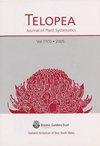菲律宾超镁质土壤中的一新种——弯曲三棱藓(桃金娘科)
IF 0.5
4区 生物学
Q4 PLANT SCIENCES
引用次数: 2
摘要
本文正式描述了一种来自菲律宾的tristiopsis flexuosa Fernando & Peter G.Wilson新种。目前,该物种仅在极端超镁铁生境的高山森林中单一地点发现,并对其保护状况进行了评估。讨论了其与马来其他三棱藓属的关系,并提供了鉴定菲律宾种的关键。本文章由计算机程序翻译,如有差异,请以英文原文为准。
Tristaniopsis flexuosa (Myrtaceae), a new species from ultramafic soils in the Philippines
A new species of Tristaniopsis (Myrtaceae) from the Philippines, Tristaniopsis flexuosa Fernando & Peter G.Wilson, is formally described and illustrated. At present, the species is known only from a single locality in upper montane forest in extreme ultramafic habitat and we provide an assessment of its conservation status. Its relationship to other Malesian species of Tristaniopsis is discussed, and a key to the identification of the Philippine species provided.
求助全文
通过发布文献求助,成功后即可免费获取论文全文。
去求助
来源期刊

Telopea
PLANT SCIENCES-
CiteScore
1.30
自引率
42.90%
发文量
0
期刊介绍:
Manuscripts submitted for publication in TELOPEA are published online, after peer review and acceptance by the TELOPEA Editorial Committee and when final editorial formatting has been completed. The journal specialises in plant systematics and phylogeny. The geographic scope of the journal encompasses Australia, Malesia, Melanesia, Micronesia, and Polynesia. The suitability of a work for the journal depends on the topic and the region of origin, generally the narrower the focus of the manuscript the closer to New South Wales must be its geographic focus.
As a general guide, we will consider:
1) revisionary treatments and other substantial bodies of work from any of the regions mentioned above.
2) new species from any Australian state.
3) new country records for Australia from any state.
4) new state records from New South Wales only.
However, we aim to support botanical research across the broader Australasian and Pacific region, and will consider submissions on their merit.
Generally we will not consider extraterritorial new country records, or single lectotypification papers unless they pertain to New South Wales taxa, or have significant bearing on the Australian flora.
 求助内容:
求助内容: 应助结果提醒方式:
应助结果提醒方式:


